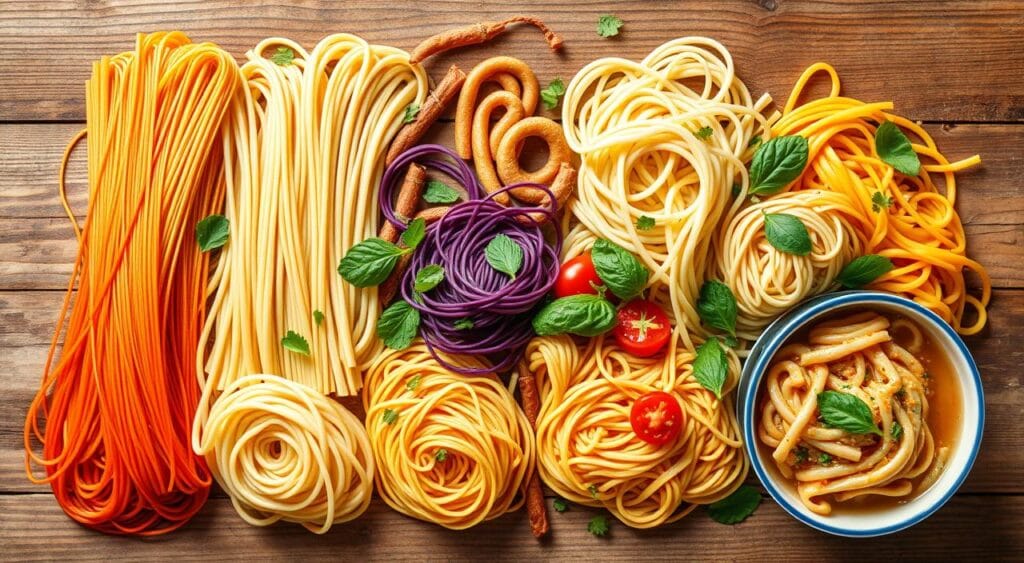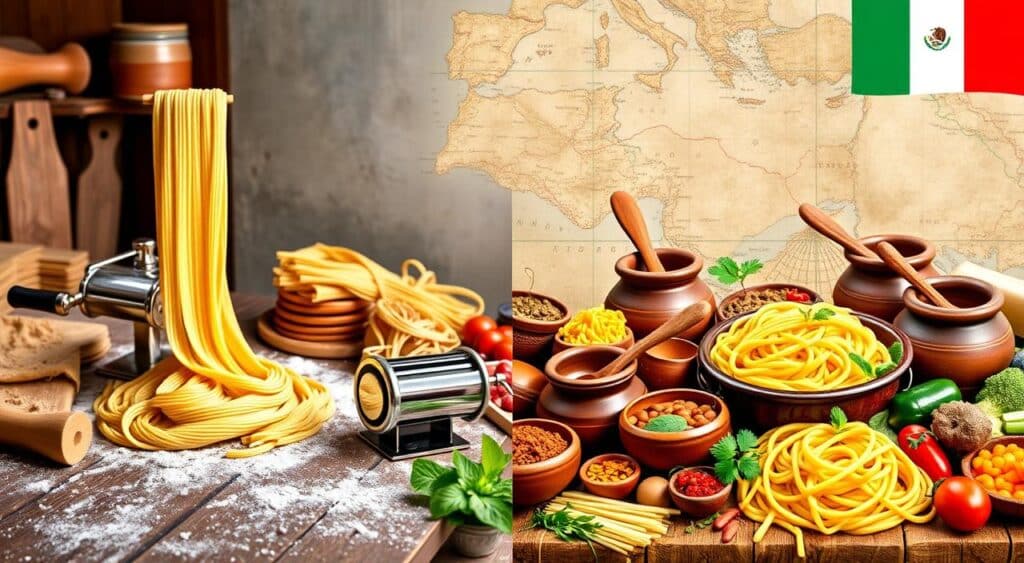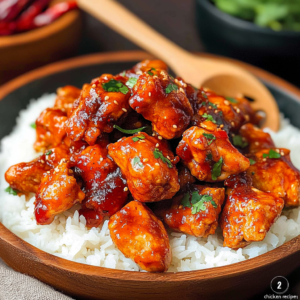Jump to:
Pasta and fideo are two different kinds of noodles. They come from different places and have unique ingredients and uses. Pasta is a big deal in Italian food, with many shapes and sizes. On the other hand, fideo is a thin, short noodle used in Mexican and Spanish dishes like sopa de fideo and fideuà.
Knowing how pasta and fideo differ helps us understand the rich food traditions of Italy and Latin America. This knowledge opens up a world of flavors and cooking techniques.
Key Takeaways
- Pasta and fideo are two distinct types of noodles with different origins, ingredients, and culinary uses.
- Pasta is a staple in Italian cuisine, known for its wide variety of shapes and sizes, while fideo refers to a specific type of thin, short noodle used in Mexican and Spanish cuisine.
- People commonly use fideo in dishes like sopa de fideo (fideo soup) and fideo, while they use pasta in a wide range of dishes across Italian and Western cuisines.
- Understanding the differences between pasta and fideo can provide insights into the diverse culinary traditions of Italy and Latin America.
- Fideo dishes often feature a unique cooking technique, such as browning the noodles in oil before adding other ingredients.
Introduction
Pasta and fideo are both key ingredients in different cuisines. They look similar but have unique origins and uses. This article will dive into their history, ingredients, cooking methods, tastes, and cultural importance. By learning about these differences, we can appreciate the variety of noodle varieties worldwide.
Fideo, a thin noodle, is a staple in Mexican cooking, especially in Sopa de Fideo (Fideo Soup). Pasta, on the other hand, is a mainstay in Italian and many global cuisines. Despite their similarities, their histories, preparation, and tastes make them distinct food culture elements.
“Exploring the nuanced differences between pasta and fideo allows us to appreciate the rich diversity of noodle-based dishes around the world.”

The Origins of Pasta and Fideo
Pasta’s history goes back to ancient Mediterranean civilizations. Fideo, however, comes from the Iberian Peninsula, influenced by Arabic cuisine during Muslim rule in Spain. Their unique histories have shaped their roles in food culture traditions.
Ingredients and Composition
Pasta and fideo both use wheat flour, but their ingredients differ. Pasta includes water, eggs, and sometimes additives. People make fideo with only wheat flour and water. These differences affect their culinary comparisons and uses.
Origins and History of Pasta and Fideo
Pasta’s history begins in ancient Italy. It shows up in the Etruscan civilization’s foods. The modern pasta we love today came from the Arabs in the 8th and 9th centuries. They introduced the method of making dried noodles.
Fideo noodles come from Spain. Arab cooking influenced them, just like it influenced pasta .”Fideo” means “noodle” in Spanish. It’s a thin, short noodle used in Spanish and Latin American dishes for centuries.
The Origin of Pasta
Pasta’s history is long and rich. It started with the Etruscan civilization in ancient Italy. Over time, the Arabs brought new ways to make noodles, changing pasta forever.
The Origin of Fideo
Fideo noodles come from Spain. “Fideo” means “noodle” in Spanish. It shows the Arab influence on Spanish cooking, just like pasta.
Historical Development and Influence
Both pasta and fideo have changed over time. They reflect the many cultures that have shaped them. From Italy to Spain and Mexico, they are key parts of local traditions. They show how food brings people together across time and space.

| Pasta | Fideo |
|---|---|
| Originated in ancient Italy, with evidence of similar noodle-based foods dating back to the Etruscan civilization. | Originated in Spain, likely influenced by the same Arab culinary traditions that shaped the development of pasta. |
| Arab influence during the 8th and 9th centuries led to the evolution of the modern pasta we know today, as they introduced the technique of making dried, extruded noodles to the region. | The word “fideo” translates to “noodle” in Spanish, indicating the noodle-like nature and usage of this versatile ingredient. |
| Pasta has undergone regional adaptations and innovations, reflecting the diverse culinary cultures that have shaped its evolution. | Fideo has been a staple in Spanish and Latin American cuisines for centuries, showcasing its historical and cultural significance. |
Ingredients and Composition
Pasta and fideo look similar, but people make them differently. Pasta is mainly durum wheat semolina and water, making it chewy. Fideo, on the other hand, uses durum and all-purpose flours for a thinner noodle. It might also have egg, unlike pasta.
Traditional Ingredients in Pasta
People make pasta from durum wheat semolina and water. Durum wheat has lots of protein, making pasta firm. The semolina, from durum wheat, is key in pasta recipes.
Common Ingredients in Fideo
Fideo is a mix of durum and all-purpose flours, making it thinner. It might also have egg, making it different from pasta.
Nutritional Comparison
Pasta and fideo have carbs, protein, and vitamins. But, their exact nutrients depend on ingredients and cooking. Pasta might have more protein, thanks to durum wheat semolina.
Noodles come in many types, like wheat, rice, buckwheat, and egg noodles. This shows how noodles are versatile and loved worldwide.
Cooking Techniques
The way to cook pasta and fideo is quite different. People usually boil pasta in salted water until it’s just right. Then, they drain it and mix it with sauce or other toppings.
Fideo, on the other hand, cooks right in the sauce or broth. It absorbs all the flavors as it simmers. Sometimes, fideo noodles are toasted in oil first. This gives them a nutty taste and a softer texture than pasta.
Unique Cooking Methods for Fideo
The traditional fideo seco dish uses dry fideo noodles. They’re toasted in oil and then simmered in a tomato-based broth. This method makes the noodles soft and flavorful.
| Ingredient | Amount |
|---|---|
| Angel hair pasta (dry weight) | 6 oz |
| Oil (separated) | 3 Tbsp |
| Chicken broth | 3 cups |
| Water | 3 cups |
| Chopped onion | 1 cup |
| Garlic cloves, minced | 2 |
| Roma tomatoes, sliced | 1 lb |
| Chipotle peppers, de-stemmed | 2 |
| Salt | 1 tsp |
| Water for sauce | 1/2 cup |
Differences in Preparation and Texture
Pasta and fideo have different textures because of how they’re cooked. Pasta is firmer, while fideo is softer. Fideo noodles are also thinner and more delicate, making them unique to eat.
“When toasting the noodles, they should change from golden to a darker brown without burning, requiring constant stirring.”
Flavor Profiles and Usage
Pasta and fideo noodles have different tastes and uses. Pasta is known for its mild taste, making it great for many sauces and toppings. Fideo, on the other hand, has a nutty flavor from being toasted in oil. It’s perfect for tomato-based and broth-based dishes.
Flavor Profile of Pasta
Pasta’s mild taste lets it blend well with many flavors. It can be paired with pesto, bolognese, or just olive oil and herbs. This way, pasta highlights the flavors of the sauce, not its own.
How Fideo Differs in Taste and Texture
Fideo noodles have a strong nutty taste from being toasted in oil. This flavor is great in sopa de fideo and fideuà. Their thin texture is also good for soups. Pasta, with its firmer texture, is better for pasta bakes and salads.
Popular Dishes Using Pasta and Fideo
Pasta is used in many dishes worldwide, from Italian classics to Asian noodle bowls. Fideo is mainly found in Mexican and Spanish dishes like sopa de fideo and fideuà. But, both are now used in new fusion dishes, showing their versatility.
“The beauty of pasta and fideo lies in their ability to serve as blank canvases, allowing the flavors of the surrounding ingredients to take center stage.”
Cultural Significance and Variations
Both pasta and fideo are deeply rooted in their cultures. Pasta is a big part of Italian cuisine, with many regional pasta varieties. Each shape, like spaghetti from Naples or rigatoni from Rome, tells a story of local tastes and traditions.
Fideo is key in Latin American and Spanish cuisines. It’s found in dishes like sopa de fideo and fideuà. These dishes show the mix of Moorish and European cooking styles in the area.
Modern Adaptations and Fusions
Today, pasta and fideo are getting new twists. Chefs and home cooks are trying out new flavors and cooking ways. This has led to many exciting noodle dishes that blend different cooking styles.
“The art of pasta preparation is highly respected, emphasizing expertise, tradition, and attention to detail in creating high-quality pasta products.”
These new takes on pasta and fideo show how versatile noodle dishes can be. They highlight the global mix of flavors and cooking methods.
Health Considerations
Both pasta and fideo can be part of a healthy diet. They have different noodle nutrition profiles but share similar food science and dietary considerations.
Pasta is rich in carbs and low in fat, making it a great energy source. It’s packed with iron, folic acid, and B-vitamins. Whole grain pasta adds extra fiber to your diet.
Fideo might have more protein and complex carbohydrates due to egg and toasting. Its thinner noodles could have a lower glycemic index than some pasta. But, the nutritional value of both depends on ingredients, cooking, and what they’re served with.
Comparing Health Aspects
The health benefits of pasta and fideo depend on the recipe and how they’re made. People with dietary considerations like diabetes should choose whole-grain options and watch portion sizes. This way, you can enjoy pasta and fideo while keeping your health in mind.
“Proper portioning of carbohydrates is essential for people with diabetes when consuming pasta, helping prevent spikes in blood sugar levels.”
Versatility in Cooking
Both pasta and fideo are very versatile in cooking. Pasta’s neutral flavor and many shapes make it great for many dishes. Fideo’s toasted flavor and thin texture are perfect for soups and stews, and it can also be used in other ways.
Versatile Uses of Pasta
There are dozens of pasta styles, showing the wide range of shapes and sizes. Larger pasta goes well with thick sauces, while skinny pasta is better with light sauces and veggies. Spaghetti is very popular in America for its versatility.
Fun shapes like Ruote and Rotelle are loved by kids, adding fun to meals.
Creative Uses of Fideo
Fideo pasta is thin and fragile, often used in soups. But it can also be used in many other dishes. Making Fideo involves basic ingredients like onion, noodles, chicken broth, and tomato sauce. It takes just 15 minutes to prepare.
Chopping onions is a key step in making Fideo, and you can adjust the consistency to your liking.
Combining Both in Dishes
You can also mix pasta and fideo in creative dishes. Some pasta types, like Acini de Pepe and Ditalini, are great for soups. Orzo, with its small grain shape, is versatile and can be paired with any sauce. Farfelle, or bow tie pasta, is thick and good at soaking up flavors.
| Pasta Type | Characteristics | Culinary Applications |
|---|---|---|
| Spaghetti | Long, thin, cylindrical shape | Versatile, pairs well with a variety of sauces |
| Farfalle (Bow Tie) | Thick, absorbent texture | Suitable for soaking up flavors in dishes |
| Orzo | Resembles small grains | Versatile, can be used with any sauce, often served as a side dish |
| Fideo | Short, thin, fragile noodles | Commonly used in soups, but also versatile in other dishes |
“Fideo is a versatile dish that can be modified to become a soup or a more refined dish.”
Conclusion
Pasta and fideo are both noodle staples, but they have different origins and uses. Pasta comes from Italian cuisine and has many shapes and sizes. It can be made in many ways.
Fideo, from Spain and Latin America, is toasted and cooked in sauces and broths. This gives it a nutty flavor and soft texture.
Learning about pasta and fideo helps us appreciate global food traditions. It also inspires us to try new recipes. By comparing these noodles, we discover the rich diversity of food cultures.
Whether you like pasta’s firm bite or fideo’s toasted taste, exploring these noodles is exciting. Knowing how to make both can make our cooking more creative and tasty. It celebrates the variety of global foods.
FAQ
What is the difference between pasta and fideo?
Pasta and fideo are two different types of noodles. Pasta comes from Italy and is known for its many shapes. Fideo, on the other hand, is a thin noodle from Mexico and Spain.
What are the key differences in the origins and history of pasta and fideo?
Pasta started in ancient Italy, with roots dating back to the Etruscan civilization. Fideo, however, comes from Spain, influenced by Arab traditions that also shaped pasta.
How do the ingredients and composition of pasta and fideo differ?
Pasta is made from durum wheat semolina, making it firm and high in protein. Fideo, made from durum and all-purpose flours, is thinner and more delicate.
What are the differences in the traditional cooking methods for pasta and fideo?
Pasta is boiled in salted water until it’s done. Fideo is cooked in sauce or broth, soaking up flavors. Fideo is also toasted in oil before cooking, adding a nutty taste.
How do the flavor profiles and culinary uses of pasta and fideo differ?
Pasta has a neutral taste, perfect for many sauces. Fideo, with its toasted flavor, is great for tomato and broth-based dishes.
What is the cultural significance and significance of pasta and fideo in their respective cuisines?
Pasta is a big part of Italian cuisine, with many regional styles. Fideo is key in Latin American and Spanish cooking, used in dishes like sopa de fideo. Both have evolved with modern twists, showing the diversity of food worldwide.
How do the health benefits and nutritional profiles of pasta and fideo compare?
Both can be healthy parts of a diet. Pasta is higher in carbs and lower in fat. Fideo might have more protein and complex carbs.
How versatile are pasta and fideo in the kitchen?
Pasta’s neutral taste and many shapes make it versatile. It’s good for classic dishes and new recipes. Fideo’s toasted flavor and thin texture are perfect for soups and stews, but it can also be used in many other dishes.





